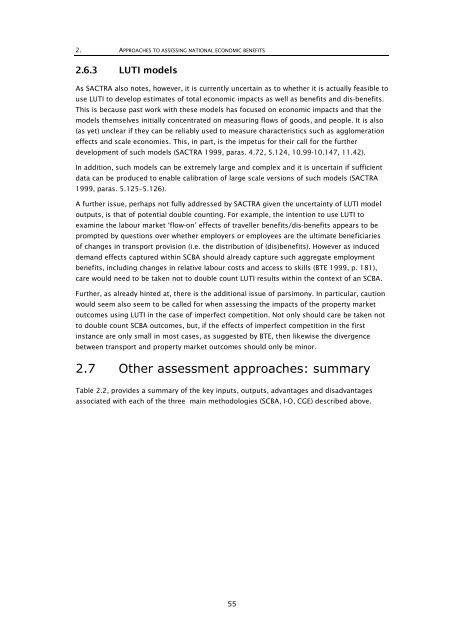Research 350 - NZ Transport Agency
Research 350 - NZ Transport Agency
Research 350 - NZ Transport Agency
Create successful ePaper yourself
Turn your PDF publications into a flip-book with our unique Google optimized e-Paper software.
2. APPROACHES TO ASSESSING NATIONAL ECONOMIC BENEFITS<br />
2.6.3 LUTI models<br />
As SACTRA also notes, however, it is currently uncertain as to whether it is actually feasible to<br />
use LUTI to develop estimates of total economic impacts as well as benefits and dis-benefits.<br />
This is because past work with these models has focused on economic impacts and that the<br />
models themselves initially concentrated on measuring flows of goods, and people. It is also<br />
(as yet) unclear if they can be reliably used to measure characteristics such as agglomeration<br />
effects and scale economies. This, in part, is the impetus for their call for the further<br />
development of such models (SACTRA 1999, paras. 4.72, 5.124, 10.99-10.147, 11.42).<br />
In addition, such models can be extremely large and complex and it is uncertain if sufficient<br />
data can be produced to enable calibration of large scale versions of such models (SACTRA<br />
1999, paras. 5.125–5.126).<br />
A further issue, perhaps not fully addressed by SACTRA given the uncertainty of LUTI model<br />
outputs, is that of potential double counting. For example, the intention to use LUTI to<br />
examine the labour market ‘flow-on’ effects of traveller benefits/dis-benefits appears to be<br />
prompted by questions over whether employers or employees are the ultimate beneficiaries<br />
of changes in transport provision (i.e. the distribution of (dis)benefits). However as induced<br />
demand effects captured within SCBA should already capture such aggregate employment<br />
benefits, including changes in relative labour costs and access to skills (BTE 1999, p. 181),<br />
care would need to be taken not to double count LUTI results within the context of an SCBA.<br />
Further, as already hinted at, there is the additional issue of parsimony. In particular, caution<br />
would seem also seem to be called for when assessing the impacts of the property market<br />
outcomes using LUTI in the case of imperfect competition. Not only should care be taken not<br />
to double count SCBA outcomes, but, if the effects of imperfect competition in the first<br />
instance are only small in most cases, as suggested by BTE, then likewise the divergence<br />
between transport and property market outcomes should only be minor.<br />
2.7 Other assessment approaches: summary<br />
Table 2.2, provides a summary of the key inputs, outputs, advantages and disadvantages<br />
associated with each of the three main methodologies (SCBA, I-O, CGE) described above.<br />
55
















